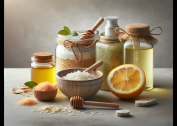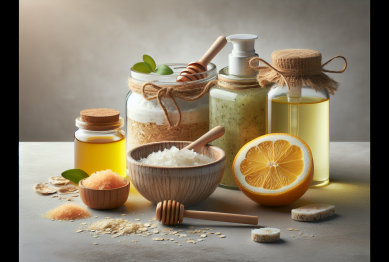Discover how mindful skin barrier care can transform how your skin looks and feels. This guide explores the science behind barrier repair, key ingredients, and practical ways to support glowing, resilient skin in daily life.
Why the Skin Barrier Matters to Wellness
The skin barrier is more than just a surface—it’s a complex shield against the outside world. When functioning well, this barrier protects against irritants, pollution, and moisture loss, acting as the first line of defense for whole-body well-being. Many factors, including stress, environment, and harsh products, can weaken this natural shield, leading to visible signs like redness, dryness, or sensitivity. It’s easy to overlook the way barrier health connects with overall wellness, but research highlights how critical this layer is in managing both appearance and comfort (Source: https://www.ncbi.nlm.nih.gov/pmc/articles/PMC5849435/).
People often notice dullness or persistent irritation and may assume it’s just sensitive skin, when in fact a compromised barrier could be the real culprit. Maintaining this layer doesn’t require complicated routines; even gentle cleansing, hydration, and sun protection can go a long way. The popularity of skin barrier repair has grown as more people realize that glowing skin comes from addressing foundational health, not just masking symptoms. Incorporating wellness strategies such as nutrition, sleep, and stress management supports the barrier from within.
Ignoring the skin barrier can lead to a cycle of damage and frustration, where even premium serums or creams seem ineffective. For those who deal with eczema, acne, or frequent flare-ups, barrier repair offers a root-cause approach. Current trends in the wellness and beauty space include avoiding aggressive exfoliants and focusing on balance over aggression. The journey toward radiant skin often starts with rebuilding and maintaining a healthy, resilient barrier.
Lipid Layer: The Foundation of Healthy Skin
Lipids—natural fats—in the skin play a crucial role in waterproofing and supporting youthful texture. Ceramides, cholesterol, and fatty acids together create a seal that locks in moisture and keeps out harmful microbes. When this lipid matrix is disrupted by overwashing or environmental factors, skin can become fragile, leading to tightness or flaking (Source: https://www.health.harvard.edu/staying-healthy/skin-barrier-and-how-to-protect-it). That’s why replenishing the skin’s own lipids is a cornerstone of barrier restoration.
High-performing creams and oils often include ingredients that mimic or boost these natural lipids. Products with ceramides or squalane help fill gaps between skin cells, making skin feel smoother and more supple. Even dietary fats, like omega-3s found in nuts and fish, support the body’s own lipid production. While trends come and go, lipids stand out as universally essential for keeping the skin barrier robust.
Often, those seeking rapid results overlook how gentle replenishment outperforms aggressive treatments. Lipid-rich formulas can comfort even acne-prone or inflamed complexions, contrary to the outdated belief that oils always worsen breakouts. Choosing skincare that prioritizes lipid support ultimately leads to more balanced, resilient skin that glows from the inside out.
Essential Ingredients for Skin Barrier Rescue
Certain ingredients have earned a reputation for barrier repair due to their proven science and versatility. Niacinamide, a form of vitamin B3, is celebrated for strengthening the skin and reducing redness. Meanwhile, panthenol (pro-vitamin B5) enhances hydration and supports healing. Both are frequently recommended by dermatologists for routines focused on skin barrier health (Source: https://www.aad.org/public/everyday-care/skin-care-secrets/routine/skin-care-products-how-to-read-labels).
Other barrier-boosting stars include hyaluronic acid for rapid moisture infusion, and allantoin for soothing upset, inflamed skin. Some prefer using single-ingredient serums to layer benefits, while others choose multipurpose products for simplicity. It’s worth noting that sunscreen acts as an indirect but powerful barrier protector, minimizing environmental stressors that trigger breakdown. Incorporating these elements can transform how skin responds to daily life.
Natural extracts like centella asiatica, colloidal oat, and licorice root have also gained attention. These botanicals calm irritation and support the repair of micro-damage. Layering these with protective balms or creams delivers a comprehensive plan for long-term barrier health. Experimenting with formulas and monitoring the skin’s reaction allows anyone to personalize their routine and see what truly works.
The Impact of Lifestyle and Nutrition on the Skin Barrier
Beyond topical treatments, lifestyle choices carry a surprising influence on the skin’s barrier function. Chronic stress, for instance, has been linked to a rise in inflammatory markers, which can weaken the skin’s resilience over time (Source: https://www.ncbi.nlm.nih.gov/pmc/articles/PMC7771121/). Practices such as meditation, regular exercise, and adequate rest help regulate these responses, supporting the skin from the inside out.
Nutrition also plays a starring role. Essential fatty acids, antioxidants, and vitamins directly contribute to the production and maintenance of the lipid barrier. Foods high in vitamin C and E, for example, aid collagen formation and provide protection against oxidative stress. Hydration from drinking water complements topical skincare, reinforcing the skin’s ability to act as a protective shield.
Alcohol, processed foods, and excessive caffeine may temporarily disrupt the delicate equilibrium of the skin barrier. Moderation and mindful eating can help preserve the moisture and strength that define healthy complexions. Many find that listening to their body—and skin—makes it easier to craft routines that align with both personal wellness and outer beauty goals.
Building a Barrier-Friendly Skincare Routine
Simplification is often the secret behind successful barrier repair. Rather than chasing viral trends, focus on gentle cleansers, nourishing moisturizers, and physical or mineral-based sunscreens. Stripping cleansers and frequent exfoliation should be minimized, as they can strip away that vital protective layer (Source: https://www.mountsinai.org/health-library/selfcare/how-to-care-for-your-skin).
Customizing skincare doesn’t have to be expensive or overwhelming. Patch testing new products reduces risk, and slow introduction helps the skin adjust. Pay attention to how skin feels after use—any burning or persistent stinging can signal barrier distress. Even experienced beauty enthusiasts find that occasionally pausing actives like retinols or exfoliants lets the skin restore its barrier integrity.
Include evening and morning routines that support rest and protection. Lightweight hydration in the morning sets the tone for the day, while richer layers at night help the barrier recover from environmental stress. Watching for trends in wellness and beauty is great for inspiration, but foundational care stays timeless.
Troubleshooting and Expert Insights on Sensitive Skin
Sometimes, despite careful skincare, unexpected sensitivity, breakouts, or flaking emerge. This common experience often signals a need for barrier-first strategies. Dermatologists and skin therapists emphasize patience—real recovery can take weeks, not days. Avoiding triggers (such as harsh weather or allergens) and sticking to soothing products make a significant difference (Source: https://www.niams.nih.gov/health-topics/skin-care).
Consulting a dermatologist provides personalized insight when issues persist. They may recommend barrier repair creams, prescription topicals, or non-invasive treatments if needed. Understanding your unique skin type helps tailor an approach, whether dryness, oiliness, or mixed concerns are at play. More people are seeking professional guidance as information about skin wellness multiplies.
Skin positivity movements encourage embracing natural texture while making informed choices about care. Instead of pursuing unrealistic ideals, focus on comfort, confidence, and skin function. Empowerment comes from learning what skin truly needs—sometimes, less is more, and patience pays off in the journey to lasting smoothness and clarity.
References
1. Draelos, Z. D. (2018). The skin barrier and how to protect it. Harvard Health Publishing. Retrieved from https://www.health.harvard.edu/staying-healthy/skin-barrier-and-how-to-protect-it
2. Elias, P. M., & Steinhoff, M. (2008). Skin barrier function. National Center for Biotechnology Information. Retrieved from https://www.ncbi.nlm.nih.gov/pmc/articles/PMC5849435/
3. American Academy of Dermatology. (n.d.). Skin care products: How to read labels. Retrieved from https://www.aad.org/public/everyday-care/skin-care-secrets/routine/skin-care-products-how-to-read-labels
4. Lee, S.-Y., & Kim, S. (2021). Effect of Stress on Skin Barrier Function. National Center for Biotechnology Information. Retrieved from https://www.ncbi.nlm.nih.gov/pmc/articles/PMC7771121/
5. Mount Sinai. (n.d.). How to care for your skin. Retrieved from https://www.mountsinai.org/health-library/selfcare/how-to-care-for-your-skin
6. National Institute of Arthritis and Musculoskeletal and Skin Diseases. (n.d.). Skin care. Retrieved from https://www.niams.nih.gov/health-topics/skin-care









